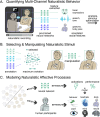Advancing Naturalistic Affective Science with Deep Learning
- PMID: 37744976
- PMCID: PMC10514024
- DOI: 10.1007/s42761-023-00215-z
Advancing Naturalistic Affective Science with Deep Learning
Abstract
People express their own emotions and perceive others' emotions via a variety of channels, including facial movements, body gestures, vocal prosody, and language. Studying these channels of affective behavior offers insight into both the experience and perception of emotion. Prior research has predominantly focused on studying individual channels of affective behavior in isolation using tightly controlled, non-naturalistic experiments. This approach limits our understanding of emotion in more naturalistic contexts where different channels of information tend to interact. Traditional methods struggle to address this limitation: manually annotating behavior is time-consuming, making it infeasible to do at large scale; manually selecting and manipulating stimuli based on hypotheses may neglect unanticipated features, potentially generating biased conclusions; and common linear modeling approaches cannot fully capture the complex, nonlinear, and interactive nature of real-life affective processes. In this methodology review, we describe how deep learning can be applied to address these challenges to advance a more naturalistic affective science. First, we describe current practices in affective research and explain why existing methods face challenges in revealing a more naturalistic understanding of emotion. Second, we introduce deep learning approaches and explain how they can be applied to tackle three main challenges: quantifying naturalistic behaviors, selecting and manipulating naturalistic stimuli, and modeling naturalistic affective processes. Finally, we describe the limitations of these deep learning methods, and how these limitations might be avoided or mitigated. By detailing the promise and the peril of deep learning, this review aims to pave the way for a more naturalistic affective science.
Keywords: Affective science; Cognitive modeling; Deep learning; Generalizability; Person perception.
© The Society for Affective Science 2023. Springer Nature or its licensor (e.g. a society or other partner) holds exclusive rights to this article under a publishing agreement with the author(s) or other rightsholder(s); author self-archiving of the accepted manuscript version of this article is solely governed by the terms of such publishing agreement and applicable law.
Conflict of interest statement
Conflict of InterestOn behalf of all authors, the corresponding author states that there is no conflict of interest.
Figures



Similar articles
-
Understanding Naturalistic Facial Expressions with Deep Learning and Multimodal Large Language Models.Sensors (Basel). 2023 Dec 26;24(1):126. doi: 10.3390/s24010126. Sensors (Basel). 2023. PMID: 38202988 Free PMC article. Review.
-
Lights, Camera, Emotion: REELMO's 1060 Hours of Affective Reports to Explore Emotions in Naturalistic Contexts.Sci Data. 2025 May 15;12(1):797. doi: 10.1038/s41597-025-05159-6. Sci Data. 2025. PMID: 40374710 Free PMC article.
-
Decoding subjective emotional arousal from EEG during an immersive virtual reality experience.Elife. 2021 Oct 28;10:e64812. doi: 10.7554/eLife.64812. Elife. 2021. PMID: 34708689 Free PMC article.
-
Naturalistic Stimuli in Affective Neuroimaging: A Review.Front Hum Neurosci. 2021 Jun 17;15:675068. doi: 10.3389/fnhum.2021.675068. eCollection 2021. Front Hum Neurosci. 2021. PMID: 34220474 Free PMC article. Review.
-
Feelings are Messy: The Feelings We Study in Affective Science Should Be Too.Affect Sci. 2024 Sep 5;5(3):190-195. doi: 10.1007/s42761-024-00263-z. eCollection 2024 Sep. Affect Sci. 2024. PMID: 39391341 Free PMC article. Review.
Cited by
-
Dynamic brain connectivity predicts emotional arousal during naturalistic movie-watching.PLoS Comput Biol. 2025 Apr 11;21(4):e1012994. doi: 10.1371/journal.pcbi.1012994. eCollection 2025 Apr. PLoS Comput Biol. 2025. PMID: 40215238 Free PMC article.
-
Emotion prediction as computation over a generative theory of mind.Philos Trans A Math Phys Eng Sci. 2023 Jul 24;381(2251):20220047. doi: 10.1098/rsta.2022.0047. Epub 2023 Jun 5. Philos Trans A Math Phys Eng Sci. 2023. PMID: 37271174 Free PMC article.
-
A Louder Call for the Integration of Multiple Nonverbal Channels in the Study of Affect.Affect Sci. 2024 Aug 26;5(3):201-208. doi: 10.1007/s42761-024-00265-x. eCollection 2024 Sep. Affect Sci. 2024. PMID: 39391348 Free PMC article.
-
Affectivism and the Emotional Elephant: How a Componential Approach Can Reconcile Opposing Theories to Serve the Future of Affective Sciences.Affect Sci. 2024 Sep 20;5(3):196-200. doi: 10.1007/s42761-024-00272-y. eCollection 2024 Sep. Affect Sci. 2024. PMID: 39391345 Free PMC article.
-
Naturalistic multimodal emotion data with deep learning can advance the theoretical understanding of emotion.Psychol Res. 2024 Dec 21;89(1):36. doi: 10.1007/s00426-024-02068-y. Psychol Res. 2024. PMID: 39708231 Free PMC article. Review.
References
-
- Arias P, Rachman L, Liuni M, Aucouturier J-J. Beyond correlation: Acoustic transformation methods for the experimental study of emotional voice and speech. Emotion Review. 2021;13(1):12–24. doi: 10.1177/1754073920934544. - DOI
-
- Arulkumaran K, Deisenroth MP, Brundage M, Bharath AA. Deep reinforcement learning: A brief survey. IEEE Signal Processing Magazine. 2017;34(6):26–38. doi: 10.1109/MSP.2017.2743240. - DOI
Publication types
LinkOut - more resources
Full Text Sources
